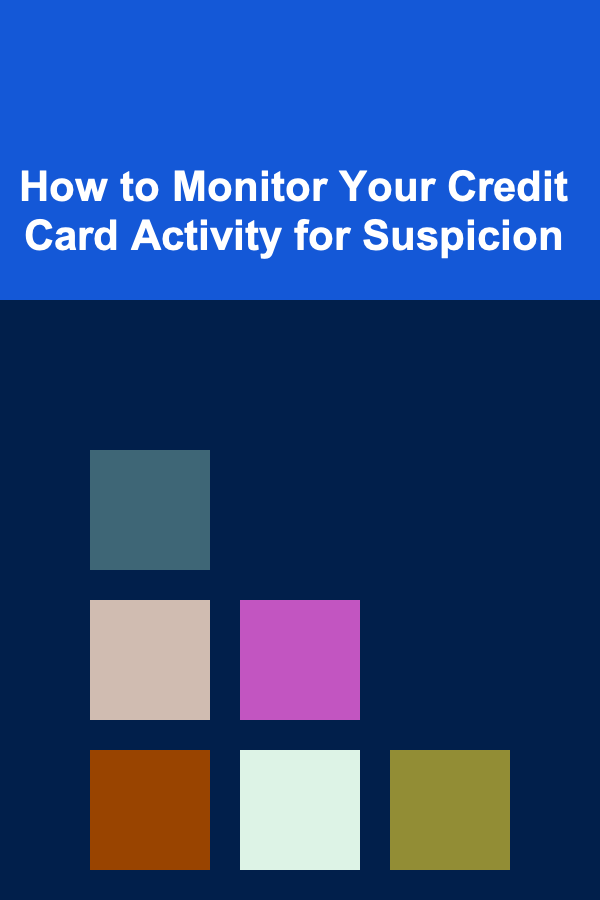
How to Monitor Your Credit Card Activity for Suspicion
ebook include PDF & Audio bundle (Micro Guide)
$12.99$10.99
Limited Time Offer! Order within the next:

Credit card fraud is a pervasive issue that affects millions of people worldwide. Fraudulent charges can quickly pile up, leaving you with unexpected debt and a disrupted financial situation. With more transactions happening online and through digital channels, monitoring your credit card activity for suspicious transactions has never been more critical. This article aims to provide you with the tools and techniques necessary to spot and address suspicious activity on your credit card.
In this guide, we will explore the importance of monitoring your credit card activity, how to recognize suspicious transactions, the various ways to protect yourself, and what to do if you notice fraudulent activity. By understanding the signs of fraud and taking proactive steps, you can safeguard your financial health and avoid falling victim to fraudsters.
Why Monitoring Credit Card Activity is Important
Credit cards are often the preferred method of payment for both small and large transactions, especially in a digital economy. As a result, your credit card details are valuable to criminals. Fraudsters can access your card information in various ways, including through data breaches, phishing schemes, and skimming devices placed on ATMs or point-of-sale terminals. Because of this, it is crucial to consistently monitor your credit card activity to ensure that all charges are legitimate.
In addition to safeguarding against fraud, regular monitoring allows you to keep track of your spending. It can help you avoid overspending, stay within your budget, and catch any discrepancies early. Proactively checking your credit card statements is an essential habit that everyone should adopt.
1. Understanding Credit Card Fraud
Credit card fraud involves the unauthorized use of someone else's credit card information to make purchases or withdraw funds. Fraudsters gain access to this information in several ways:
- Data Breaches: Large-scale breaches of retailers, financial institutions, or other organizations can result in stolen credit card information.
- Phishing Scams: Fraudsters impersonate legitimate companies or banks to trick people into providing their credit card details.
- Skimming: Fraudsters use devices to copy card information from magnetic strips when the card is swiped at ATMs or in-store terminals.
- Card Not Present Fraud: This occurs when a fraudster uses stolen credit card details for online or phone transactions where the physical card is not required.
Regardless of how fraudsters obtain your credit card details, it's essential to be vigilant and take steps to monitor your activity regularly to catch any unusual transactions as early as possible.
How to Monitor Credit Card Activity
Effective monitoring involves a combination of manual and automated methods. Fortunately, most financial institutions provide tools to help track your spending. Here's how you can stay on top of your credit card activity.
1. Check Your Credit Card Statements Regularly
The most straightforward way to monitor your credit card activity is to review your monthly credit card statement. Your statement will include details about every transaction made within that billing cycle. Pay close attention to:
- Purchase Dates and Amounts: Review each transaction's date and amount. Any unfamiliar charges should be investigated further.
- Merchant Names: Ensure the merchant names match the places where you've recently made purchases. If a merchant name seems unfamiliar or incorrect, it could indicate fraudulent activity.
- Recurring Charges: Check for any recurring charges, such as subscriptions or memberships, that you may have forgotten about or no longer use.
2. Use Your Credit Card Issuer's Mobile App
Most credit card issuers provide mobile apps that allow you to monitor your account in real-time. These apps typically have features that include:
- Instant Notifications: Enable transaction alerts on your mobile app. These notifications will alert you immediately whenever a transaction is made, allowing you to spot any suspicious charges quickly.
- View Transactions: The app allows you to track your spending, view transaction history, and see detailed information about each charge.
- Manage Account Settings: You can also use the app to manage your payment methods, adjust credit limits, and even lock or freeze your card if suspicious activity is detected.
3. Sign Up for Alerts and Notifications
Set up automatic alerts with your bank or credit card issuer to receive notifications for various activities, such as:
- Large Purchases: Alerts for any transactions above a certain threshold can help you keep track of unexpected large purchases.
- Foreign Transactions: If you're not traveling, you may want to receive notifications about purchases made from foreign countries.
- Daily or Weekly Summary: Some issuers allow you to set up daily or weekly summaries of your account activity. This provides a periodic overview of your spending and helps you catch any issues early.
4. Check Your Credit Score Regularly
Fraudulent credit card activity can affect your credit score, particularly if the fraud goes unnoticed for a prolonged period. By regularly checking your credit score, you can spot any discrepancies that could arise due to fraudulent charges. Several services allow you to check your credit score for free, and most offer detailed reports of your credit activity.
- Annual Free Credit Report: You are entitled to one free credit report per year from each of the three major credit bureaus---Equifax, Experian, and TransUnion. Reviewing your credit report allows you to spot potential signs of identity theft, such as new accounts or hard inquiries you didn't authorize.
5. Track Your Spending Habits
Keeping track of your personal spending habits can help you notice any unusual activity on your account. You can use budgeting apps or even simple spreadsheets to monitor your expenses. Comparing your expected spending to your actual charges will allow you to see if there are any discrepancies that need to be investigated.
Red Flags of Suspicious Activity
The key to effective credit card monitoring is knowing what to look for. Here are common red flags that could indicate fraudulent activity:
1. Unfamiliar Transactions
The most obvious sign of fraud is a charge you don't recognize. If you see any unfamiliar merchants or transactions you don't remember making, investigate them immediately. Common examples of suspicious charges include:
- Small test transactions that fraudsters often make to check if a stolen card is working.
- Charges from foreign merchants, particularly if you haven't traveled internationally recently.
- Multiple small purchases in a short time frame.
2. Transactions at Odd Hours
Fraudulent charges may occur at unusual times. For example, charges made late at night or during early morning hours might indicate that your credit card information has been compromised.
3. Multiple Declined Transactions
If you notice that your card is being declined multiple times in a short period, it could indicate that someone is attempting to use your card for unauthorized transactions. This might occur when fraudsters try to test a stolen card number.
4. Unusually High Spending
If you typically make small, everyday purchases but suddenly see large transactions that don't align with your usual spending, this could be a sign of fraud. For example, a sudden large purchase at a luxury retailer could indicate that someone else is using your card.
5. Recurring Charges You Don't Recognize
Keep an eye out for recurring charges that you don't recognize, especially those that appear to be for services you no longer use or that you never signed up for. Some fraudsters take advantage of these unnoticed recurring charges, which may seem like small amounts each month but add up over time.
What to Do if You Suspect Fraud
If you notice suspicious activity on your credit card, it's essential to take immediate action. Here's what you should do:
1. Contact Your Credit Card Issuer
If you notice any unauthorized charges, call your credit card issuer right away. Most credit card companies have a 24/7 fraud hotline. Explain the situation and ask them to block your card to prevent further charges. They will typically initiate an investigation and may offer you a new card with a different number.
2. Dispute the Charges
Once you've contacted your credit card issuer, file a dispute for any fraudulent charges. Most credit card companies have a process in place to resolve disputed charges. They will investigate the issue and, if fraud is confirmed, reverse the charges.
3. Change Your Passwords and PINs
If you suspect your card details have been compromised, change any passwords or PINs associated with your credit accounts. This includes online banking and merchant accounts where your card is stored. Consider using a password manager to securely store your new passwords.
4. Monitor Your Account for Further Activity
After reporting fraudulent activity, continue to monitor your credit card and bank statements regularly. This will ensure that no further fraudulent transactions occur. You should also continue to track your credit report for any unauthorized accounts or activities.
5. Report the Fraud to the Authorities
In some cases, especially if the fraud is extensive, you may need to report the issue to local law enforcement or file a report with the Federal Trade Commission (FTC) or your country's equivalent fraud reporting agency. This can help prevent further fraud and may assist in recovering your losses.
Conclusion
Monitoring your credit card activity for suspicious transactions is essential in today's digital age. By regularly reviewing your credit card statements, setting up alerts, tracking your spending, and staying vigilant for red flags of fraud, you can significantly reduce the risk of becoming a victim of credit card fraud.
If you do detect suspicious activity, prompt action is crucial. By contacting your credit card issuer, disputing unauthorized charges, and reporting the fraud, you can limit the damage and protect your finances. Ultimately, being proactive and educated about credit card fraud will give you the tools you need to safeguard your financial security.

How to Build a Spring Cleaning Checklist for Pets and Pet Areas
Read More
How To Use Baited Remote Underwater Video (BRUV)
Read More
How To Play Co-op Shooters for Teamwork
Read More
How to Develop a Private Blockchain
Read More
From Chaos to Calm: Organizing Your Family Life
Read More
10 Common Art Director Mistakes and How to Avoid Them
Read MoreOther Products

How to Build a Spring Cleaning Checklist for Pets and Pet Areas
Read More
How To Use Baited Remote Underwater Video (BRUV)
Read More
How To Play Co-op Shooters for Teamwork
Read More
How to Develop a Private Blockchain
Read More
From Chaos to Calm: Organizing Your Family Life
Read More